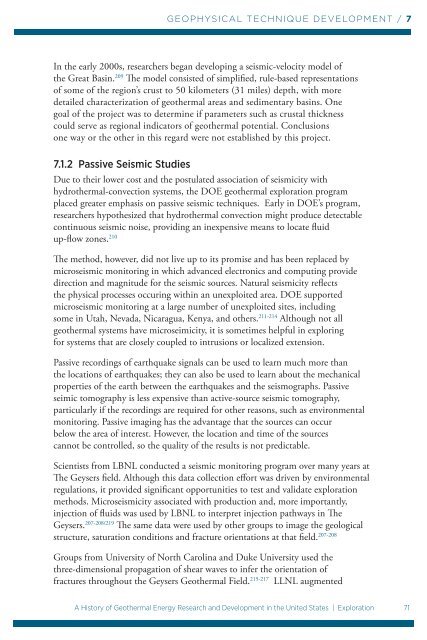A History of Geothermal Energy Research and Development in the ...
A History of Geothermal Energy Research and Development in the ...
A History of Geothermal Energy Research and Development in the ...
You also want an ePaper? Increase the reach of your titles
YUMPU automatically turns print PDFs into web optimized ePapers that Google loves.
GEOPHYSICAL TECHNIQUE DEVELOPMENT / 7<br />
In <strong>the</strong> early 2000s, researchers began develop<strong>in</strong>g a seismic-velocity model <strong>of</strong><br />
<strong>the</strong> Great Bas<strong>in</strong>. 209 The model consisted <strong>of</strong> simplified, rule-based representations<br />
<strong>of</strong> some <strong>of</strong> <strong>the</strong> region’s crust to 50 kilometers (31 miles) depth, with more<br />
detailed characterization <strong>of</strong> geo<strong>the</strong>rmal areas <strong>and</strong> sedimentary bas<strong>in</strong>s. One<br />
goal <strong>of</strong> <strong>the</strong> project was to determ<strong>in</strong>e if parameters such as crustal thickness<br />
could serve as regional <strong>in</strong>dicators <strong>of</strong> geo<strong>the</strong>rmal potential. Conclusions<br />
one way or <strong>the</strong> o<strong>the</strong>r <strong>in</strong> this regard were not established by this project.<br />
7.1.2 Passive Seismic Studies<br />
Due to <strong>the</strong>ir lower cost <strong>and</strong> <strong>the</strong> postulated association <strong>of</strong> seismicity with<br />
hydro<strong>the</strong>rmal-convection systems, <strong>the</strong> DOE geo<strong>the</strong>rmal exploration program<br />
placed greater emphasis on passive seismic techniques. Early <strong>in</strong> DOE’s program,<br />
researchers hypo<strong>the</strong>sized that hydro<strong>the</strong>rmal convection might produce detectable<br />
cont<strong>in</strong>uous seismic noise, provid<strong>in</strong>g an <strong>in</strong>expensive means to locate fluid<br />
up-flow zones. 210<br />
The method, however, did not live up to its promise <strong>and</strong> has been replaced by<br />
microseismic monitor<strong>in</strong>g <strong>in</strong> which advanced electronics <strong>and</strong> comput<strong>in</strong>g provide<br />
direction <strong>and</strong> magnitude for <strong>the</strong> seismic sources. Natural seismicity reflects<br />
<strong>the</strong> physical processes occur<strong>in</strong>g with<strong>in</strong> an unexploited area. DOE supported<br />
microseismic monitor<strong>in</strong>g at a large number <strong>of</strong> unexploited sites, <strong>in</strong>clud<strong>in</strong>g<br />
some <strong>in</strong> Utah, Nevada, Nicaragua, Kenya, <strong>and</strong> o<strong>the</strong>rs. 211-214 Although not all<br />
geo<strong>the</strong>rmal systems have microseimicity, it is sometimes helpful <strong>in</strong> explor<strong>in</strong>g<br />
for systems that are closely coupled to <strong>in</strong>trusions or localized extension.<br />
Passive record<strong>in</strong>gs <strong>of</strong> earthquake signals can be used to learn much more than<br />
<strong>the</strong> locations <strong>of</strong> earthquakes; <strong>the</strong>y can also be used to learn about <strong>the</strong> mechanical<br />
properties <strong>of</strong> <strong>the</strong> earth between <strong>the</strong> earthquakes <strong>and</strong> <strong>the</strong> seismographs. Passive<br />
seimic tomography is less expensive than active-source seismic tomography,<br />
particularly if <strong>the</strong> record<strong>in</strong>gs are required for o<strong>the</strong>r reasons, such as environmental<br />
monitor<strong>in</strong>g. Passive imag<strong>in</strong>g has <strong>the</strong> advantage that <strong>the</strong> sources can occur<br />
below <strong>the</strong> area <strong>of</strong> <strong>in</strong>terest. However, <strong>the</strong> location <strong>and</strong> time <strong>of</strong> <strong>the</strong> sources<br />
cannot be controlled, so <strong>the</strong> quality <strong>of</strong> <strong>the</strong> results is not predictable.<br />
Scientists from LBNL conducted a seismic monitor<strong>in</strong>g program over many years at<br />
The Geysers field. Although this data collection effort was driven by environmental<br />
regulations, it provided significant opportunities to test <strong>and</strong> validate exploration<br />
methods. Microseismicity associated with production <strong>and</strong>, more importantly,<br />
<strong>in</strong>jection <strong>of</strong> fluids was used by LBNL to <strong>in</strong>terpret <strong>in</strong>jection pathways <strong>in</strong> The<br />
Geysers. 207-208/219 The same data were used by o<strong>the</strong>r groups to image <strong>the</strong> geological<br />
structure, saturation conditions <strong>and</strong> fracture orientations at that field. 207-208<br />
Groups from University <strong>of</strong> North Carol<strong>in</strong>a <strong>and</strong> Duke University used <strong>the</strong><br />
three-dimensional propagation <strong>of</strong> shear waves to <strong>in</strong>fer <strong>the</strong> orientation <strong>of</strong><br />
fractures throughout <strong>the</strong> Geysers <strong>Geo<strong>the</strong>rmal</strong> Field. 215-217 LLNL augmented<br />
A <strong>History</strong> <strong>of</strong> <strong>Geo<strong>the</strong>rmal</strong> <strong>Energy</strong> <strong>Research</strong> <strong>and</strong> <strong>Development</strong> <strong>in</strong> <strong>the</strong> United States | Exploration 71

















